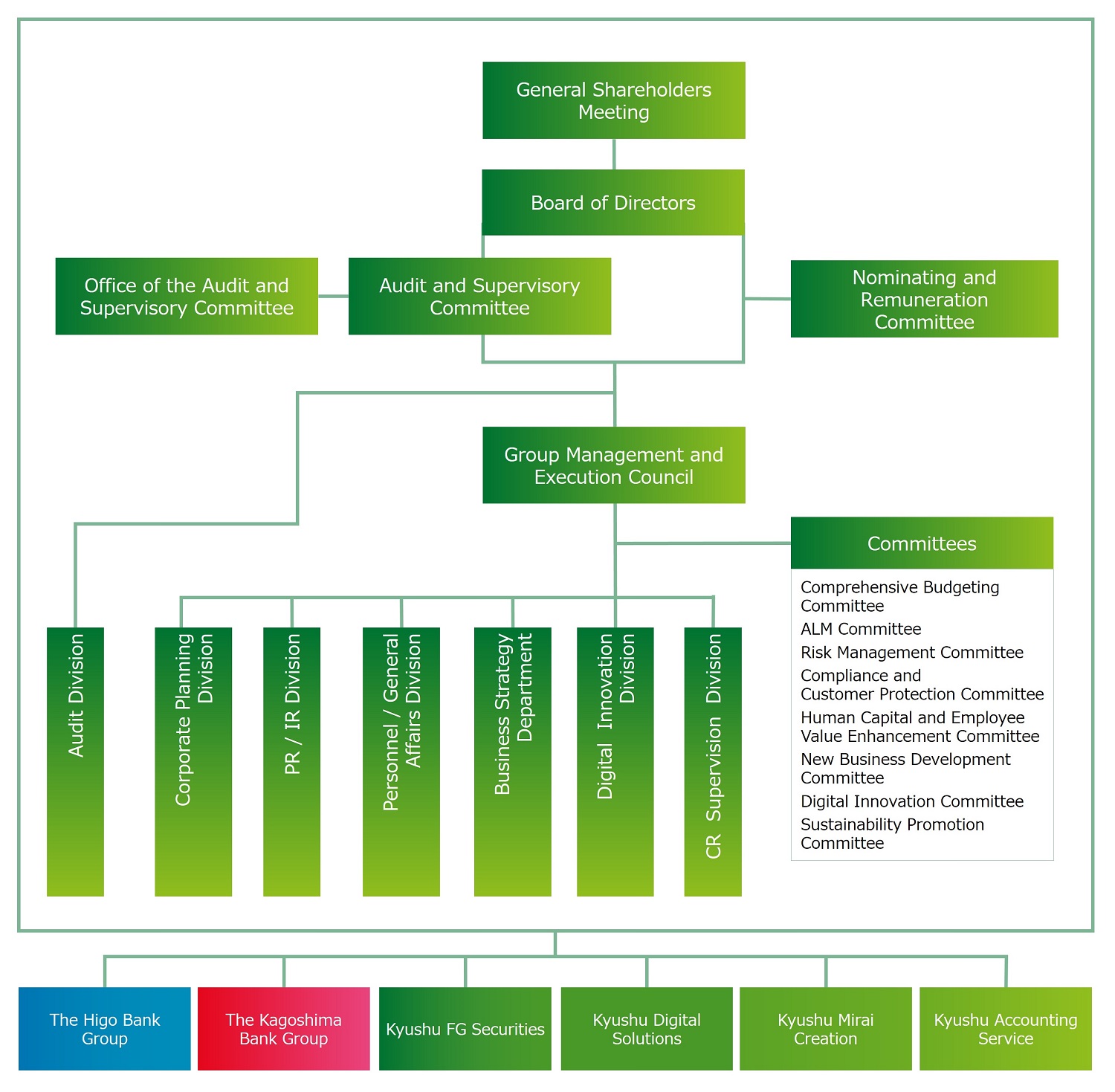Corporate Governance
Our basic stance on corporate governance
Kyushu Financial Group establishes Group Philosophy System and will comply with the laws and regulations and ensure appropriate decision-making and operations for its realization. It will also strive to achieve a high degree of management transparency, openness to the public, and soundness of operation to enhance corporate governance.
Our basic stance on the corporate governance system
- We clearly define supervision of management and execution of duties in order to establish an environment that allows the Board of Directors to focus on the supervision of the performance of Directors’ duty, thereby ensuring the effectiveness of corporate governance.
- The Board of Directors delegates decision-making on the execution of individual operations to Senior Management wherever possible unless it involves matters specified in laws and regulations or the articles of incorporation, or material matters of execution of operations such as policies, strategies, or plans pertaining to the company’s operation.
- Kyushu Financial Group has in place and leverages optional internal bodies, including the Group Management Council and other various committees, in order to support Senior Management in prompt and decisive decision-making, thereby ensuring flexible execution of operations and enhancing our corporate governance.
- We leverage objective views offered by our outside officers wherever possible in order to ensure the fairness and transparency of our decision-making process pertaining to our operation.
Corporate governance structure

- [Our corporate governance system]
- Based on the above basic concept regarding the corporate governance system, the Group aims to speeding up and streamlining decisions through delegation of authority at the Board of Directors’ meeting which consists of 14 Directors (including 5 outside directors) to further enhance discussions on medium to long-term management strategies. The Group also has adopted the form of a Company with an Audit and Supervisory Committee with outside directors as its majority members, based on the judgment that it is appropriate to enhance the supervisory function of the Board of Directors by granting voting rights to the directors who are audit and supervisory committee members (“the committee members”) at the Board of Directors’ meeting for strengthening corporate governance.
Articles of Incorporation
- [Board of Directors and Directors]
- The Board of Directors comprises 9 Directors (including 2 Audit and Supervisory Committee members) from the Group who are thoroughly familiar with the financial business, as well as 5 Outside Directors (including 3 Audit and Supervisory Committee members) who have a high degree of independence in supervising the entire management of the Group from a neutral and objective perspective. The main role of the Board is making decisions on matters stipulated by laws and regulations and the articles of incorporation, as well as important operational matters related to the management of the Group (e.g., material matters concerning management strategies, compliance with laws and regulations, risk management, and customer protection and management), and supervising the execution of duties by the Directors. The term of office for a Director other than audit and supervisory committee members is one year in accordance with the articles of incorporation.
Articles of Incorporation
- [Audit and Supervisory Committee and the Committee Members]
- The Audit and Supervisory Committee comprises 2 Audit and Supervisory Committee members from the Group who are thoroughly familiar with the financial business and possess suitable knowledge of finance and accounting, as well as 3 outside Audit and Supervisory Committee members (including 1 female Audit and Supervisory Committee member) who have a high degree of independence in conducting audits to secure Group soundness and legality from a neutral and objective perspective. The Committee carries out audits of the operations and financial conditions of the Group based on the Standards for Audits Conducted by Audit and Supervisory Committee, etc. In addition, the Audit and Supervisory Committee has set the evaluation standards for the Accounting Auditor and policies for dismissal or non-reappointment. It regularly evaluates the performance of the Accounting Auditor, and determine the details of proposals to be submitted to the general meeting of shareholders regarding appointment, dismissal or non-reappointment of the Accounting Auditor.The term of office for a committee member is 2 years in accordance with the articles of incorporation.
- [Nominating and Remuneration Committee]
- This Committee, composed of 2 Representative Directors and 3 independent outside officers, has been established for the purpose of raising the transparency and fairness of the decision-making process and contributing to strengthening corporate governance through focused discussions and exchanges of opinions pertaining to the nomination and remuneration of our management (Directors and Executive Officers).
- [Group Management and Execution Council]
- Group Management and Execution Council comprises Representative Directors and Executive Officers, etc. above the position of Managing Executive Officer, and deliberates and makes decisions on matters delegated by the Board of Directors as well as deliberates important matters regarding the Group’s management, and works to enrich and enliven the discussions for prompt and decisive decision making.
- [Committees under the Group Management and Execution Council]
- The following 8 committees each regularly discuss matters for which they are responsible in order to effectively, efficiently, and promptly address the Group’s cross-organizational issues. They submit and report material matters to the Group Management and Execution Council or the Board of Directors.
- (Comprehensive Budgeting Committee)
- The Comprehensive Budgeting Committee discusses the Group’s overall budget, progress toward goals, and cross-organizational issues, among others, based on the Medium-Term Management Plan.
- (ALM Committee)
- The ALM Committee discusses the comprehensive management of the Group’s assets and liabilities as a whole, along with matters regarding various measures.
- (Risk Management Committee)
- The Risk Management Committee discusses matters concerning the comprehensive management of various risks, including the Group’s integrated risks.
- (Compliance and Customer Protection Committee)
- The Compliance and Customer Protection Committee discusses matters concerning the comprehensive management of the Group, including compliance with laws and regulations and customer protection.
- (Human Capital and Employee Value Enhancement Committee)
- The Human Capital and Employee Value Enhancement Committee discusses the formulation, implementation, and verification of the effectiveness of policies and strategies, etc. concerning the Group’s human capital management and employee value enhancement.
- (New Business Development Committee)
- The New Business Development Committee discusses matters concerning new businesses launched to help increase the Group’s consolidated revenue, the exploration of new revenue sources, and new domestic and overseas markets for our business domains.
- (Digital Innovation Committee)
- The Digital Innovation Committee discusses matters concerning the development, implementation, and effectiveness evaluation of policies and strategies regarding how to take advantage of digital technologies adopted to change the Group’s marketing and business processes and how to develop the infrastructure for these technologies.
- (Sustainability Promotion Committee)
- The Sustainability Promotion Committee periodically ascertains the status of the Group’s efforts to implement measures related to sustainability, and conducts cross-organizational discussion on measures, etc. contributing to sustainability of the Group, customers, and local communities.
Corporate governance material
Please refer to the following material for detailed information regarding corporate governance of Kyushu Financial Group.

